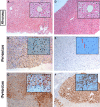Negative HBcAg in immunohistochemistry assay of liver biopsy is a predictive factor for the treatment of patients with nucleos(t)ide analogue therapy
- PMID: 29193766
- PMCID: PMC5824392
- DOI: 10.1111/jcmm.13444
Negative HBcAg in immunohistochemistry assay of liver biopsy is a predictive factor for the treatment of patients with nucleos(t)ide analogue therapy
Abstract
The hepatitis B core antigen (HBcAg) is an important target for antiviral response in chronic hepatitis B (CHB) patients. However, the correlation between HBcAg in the hepatocyte nucleus and nucleos(t)ide analogue (NA) therapeutic response is unclear. We sought to evaluate the role of HBcAg by analysing liver biopsies for viral response in NA-naïve hepatitis B e antigen (HBeAg) positive (+) CHB patients via immunohistochemistry (IHC). A total of 48 HBcAg-negative (-) patients and 48 HBcAg (+) patients with matching baseline characteristics were retrospectively analysed for up to 288 weeks. Virological response (VR) rates of patients in the HBcAg (-) group were significantly higher at week 48 and 96 than the HBcAg (+) group (77.1% versus 45.8% at week 48, respectively, P = 0.002 and 95.3% versus 83.3% at week 96, respectively, P = 0.045). The serological negative conversion rate of HBeAg was significantly higher in the HBcAg (-) than in the HBcAg (+) group from week 96 to 288 (35.4 % versus 14.6% at week 96, respectively, P = 0.018; 60.4% versus 14.6%, respectively, P < 0.001 at week 144; 72.9% versus 35.4%, respectively, P < 0.001 at week 288). The cumulative frequencies of VR and lack of HBeAg were higher in the HBcAg (-) group (both P < 0.05). Binary logistic regression analysis showed that HBcAg (-) was the predictor for the lack of HBeAg (OR 4.482, 95% CI: 1.58-12.68). In summary, the absence of HBcAg in the hepatocyte nucleus could be an independent predictor for HBeAg seroconversion rates during NA-naïve treatment in HBeAg (+) CHB patients.
Keywords: chronic hepatitis B; hepatitis B core antigen; hepatitis B e antigen; immunohistochemistry; nucleos(t)ide analogue.
© 2017 The Authors. Journal of Cellular and Molecular Medicine published by John Wiley & Sons Ltd and Foundation for Cellular and Molecular Medicine.
Figures



Similar articles
-
Expression of Hepatocyte Hepatitis B Core Antigen and Hepatitis B Surface Antigen as a Marker in the Management of Chronic Hepatitis B Patients.Gut Liver. 2017 May 15;11(3):417-425. doi: 10.5009/gnl16148. Gut Liver. 2017. PMID: 28208002 Free PMC article.
-
Intrahepatic distribution of hepatitis B virus antigens in patients with and without hepatocellular carcinoma.World J Gastroenterol. 2016 Mar 28;22(12):3404-11. doi: 10.3748/wjg.v22.i12.3404. World J Gastroenterol. 2016. PMID: 27022222 Free PMC article.
-
Intrahepatic response markers in chronic hepatitis B patients treated with peginterferon alpha-2a and adefovir.J Gastroenterol Hepatol. 2011 Oct;26(10):1527-35. doi: 10.1111/j.1440-1746.2011.06766.x. J Gastroenterol Hepatol. 2011. PMID: 21557773 Clinical Trial.
-
Effects of IFN monotherapy versus combined therapy on HBeAg seroconversion or seroclearance in HBeAg-positive chronic hepatitis B patients: A meta-analysis.Microb Pathog. 2020 Feb;139:103912. doi: 10.1016/j.micpath.2019.103912. Epub 2019 Dec 6. Microb Pathog. 2020. PMID: 31816402
-
Treatment of chronic hepatitis B virus infection - Dutch national guidelines.Neth J Med. 2008 Jul-Aug;66(7):292-306. Neth J Med. 2008. PMID: 18663260 Review.
Cited by
-
Insights into the genetic diversity, recombination, and systemic infections with evidence of intracellular maturation of hepadnavirus in cats.PLoS One. 2020 Oct 23;15(10):e0241212. doi: 10.1371/journal.pone.0241212. eCollection 2020. PLoS One. 2020. PMID: 33095800 Free PMC article.
-
Long-term inhibition of Hepatitis B virus gene expression by a primary microrna expressing ancestral adeno-associated viral vector.Virol J. 2025 Feb 17;22(1):41. doi: 10.1186/s12985-025-02662-5. Virol J. 2025. PMID: 39962472 Free PMC article. Review.
References
-
- Ott JJ, Stevens GA, Groeger J, et al Global epidemiology of hepatitis B virus infection: new estimates of age‐specific HBsAg seroprevalence and endemicity. Vaccine. 2012; 30: 2212–9. - PubMed
-
- Chen CJ, Yang HI, Su J, et al Risk of hepatocellular carcinoma across a biological gradient of serum hepatitis B virus DNA level. JAMA. 2006; 295: 65–73. - PubMed
-
- Yuen MF, Hou JL, Chutaputti A. Asia Pacific working party on prevention of hepatocellular carcinoma. J Gastroenterol Hepatol. 2009; 24: 346–53. - PubMed
-
- Raimondo G, Recchia S, Lavarini C, et al Dane particle‐associated hepatitis B e antigen in patients with chronic hepatitis B virus infection and hepatitis B e antibody. Hepatology. 1982; 2: 449–54. - PubMed
Publication types
MeSH terms
Substances
LinkOut - more resources
Full Text Sources
Other Literature Sources

